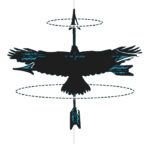Kat isn’t moving. She autographs the open house sign-in sheet with a pseudonym because anonymity feels like floating. Although she isn’t moving, Kat’s Sunday afternoons are spent inside strangers’ homes, peeking into cabinets and closets to examine the things that tether them to the world. Sometimes other people’s belongings stir a hibernating memory and she becomes both lost and attached. The glisten of a button in a bowl once reminded her so much of a goldfish she’d had when she was six that she’d swallowed it.
In this house, the pervasive smell of fresh paint and floor polish follows her like a theme song. Kat heads straight for the kitchen sink, touches the sponge to see if it’s damp and notices there’s a pale tan line where her ring used to be. A vintage-looking pearl necklace coiled on a shelf tempts her to run her teeth along its stones and feel for grit. If they are bumpy, then they are real. Pearls in a kitchen conjure up images of sitcom mothers with wide perfect smiles, women whose pearls would be real, but whose teeth would be fake. Kat’s own mother used to sit at their kitchen table and chain smoke while writing tear-damp letters from behind her feathered hair.
Audubon bird prints line the hallway just beyond the kitchen; the real estate agent’s voice sparks off their black picture frames. He boasts about built-in storage, and the young couple standing at attention in front of him nods with approval. From the backs of their heads, Kat knows they are newly married and admire Norman Rockwell paintings. They are shiny apple clean, the husband’s plaid shirt is tucked firmly into his ironed khakis and the wife has no panty lines. Standing this close to each other, they look like one of those drawings that uses negative space to question visual perception. Is this a picture of two faces or a candlestick?
Their sure-footed steps echo up the uncarpeted stairs, and through a vent in the ceiling she can hear the agent and the Norman Rockwell couple talking. It would feel like eavesdropping if the kitchen wasn’t so bright. The bass rumble of male laughter vibrates her ear drum when the agent cracks a joke about his and hers closets. Kat turns on the faucet to wash their crude humor down the drain.
Before she broke off her engagement, her mother had made bridal shower invitations from a photo she had of eight-year-old Kat wearing her wedding dress. The dress was all stiff peaks of tulle and rough lace and had belonged to her Aunt Lois before it belonged to her mother, though Aunt Lois hadn’t needed to hide a pregnancy inside it. Kat looks at the homeowner’s necklace still unbitten in her hand and realizes she’s been inside a wedding dress twice but had never had a wedding.
The agent bids the newlyweds goodbye with a flurry of handshakes and head nods. As he shuts the front door, Kat imagines him walking up behind her and wrapping his arms around her waist, sniffing her hair or maybe pushing his thumb into her navel to stir the vestigial reflex in her groin. Perhaps she could overlook the crass closet joke he made to the Norman Rockwells and wonder instead if he was just filling silence the way people do. It’s human nature, after all, to stuff what is empty. To gobble up quiet with loud noises, consume kitchen tiles or pearls in order ignore the negative space, the things most visceral.
He doesn’t hug her from behind or nibble her ear, instead he holds out his business-card hand and introduces himself. In his suit he looks like a baby seal; soft and vulnerable and expensive. Do you like what you see? he asks, and his tone makes her question whether he is referring only to the house. And briefly, in the light of the yellow kitchen, she likes it all too much. Kat reaches her hand around his neck and kisses him with her mouth open. Their front teeth bang together and he laughs down her throat. She bites down on his tongue and is almost as gentle as she would have been if she’d tested the authenticity of the pearls she so smoothly slipped into the front pocket of her dress.
—
Amie Souza Reilly lives in Connecticut with her husband and ten-year-old son. She teaches in the English department at Norwalk Community College and Sacred Heart University and is the Feminist Fridays writer for The Adroit Journal. Her most recent work can be found in The New Engagement, Entropy, The Ekphrastic Review, and Toasted Cheese.
Petra Zehner is a German-born graphic artist and photographer based in Paris, France. She works with found images and media as well as her own photographs to create minimalistic mixed media collages and illustrations.
Links
Instagram: @petrazehner.art
This shortcode LP Profile only use on the page
Profile
